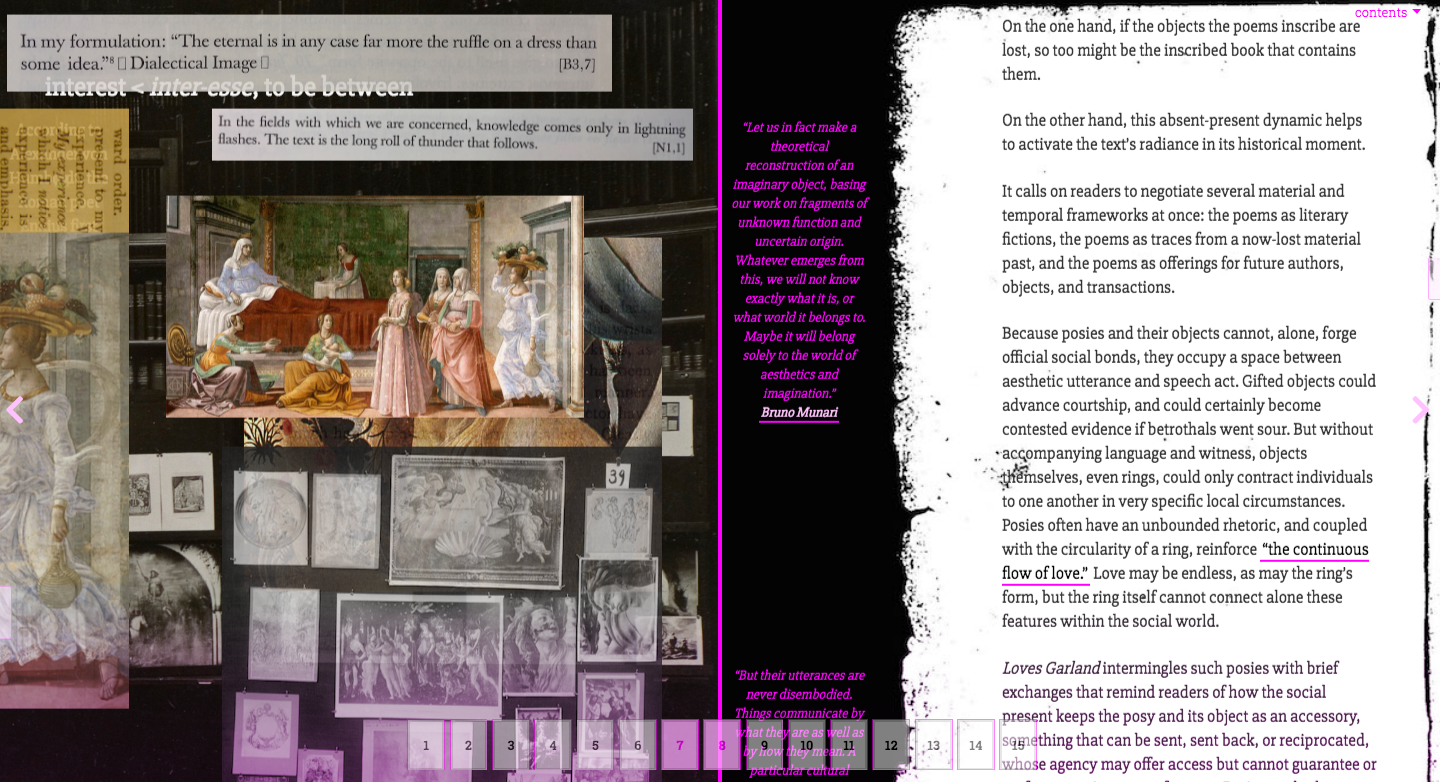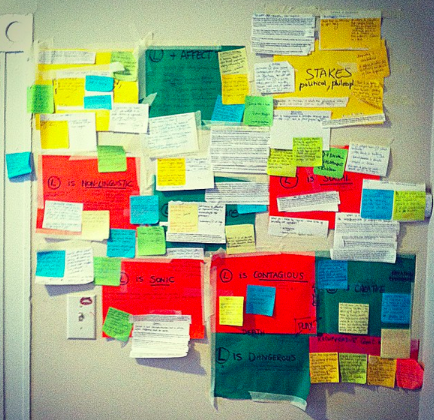How We Write (Well)
"We are at stake to each other."
— Donna Haraway
"The two of us wrote Anti-Oedipus together. Since each of us was several, there was already quite a crowd."
— Deleuze & Guattari, A Thousand Plateaus
The opening lines of A Thousand Plateaus, reproduced above as the second of my two epigraphs, offers a powerful model of collaborative writing in the humanities. Co-writing, Gilles Deleuze and Felix Guattari suggest, is the activity of overlaying and interweaving one voice with another until a recombinant voice, a voice that is neither Guattari nor Deleuze, comes into being. Legion-like, it intones, "We are no longer ourselves. We have been aided, inspired, multiplied."1 This new voice presumes a new type of book, one that "has neither object nor subject," and so finds itself lighter on its feet, more able to move. Anti-Oedipus was written primarily through letters, with Guattari mailing pages to Deleuze who would then rework and revise them for publication. While each collaborator had his own set role— Guattari the "diamond miner" or the "ocean" and Deleuze the "polisher" or the "hill," depending upon which of Deleuze's two analogies you wish to alight—the production of ideas and words was, finally, unattributable.2 As Deleuze puts it in a 1991 interview, "Each of us functions like an incrustation or a citation in the other one's text, and then, after a while, we're not sure who is citing whom anymore. It's a sort of writing made up of variations."3
While Deleuze and Guattari's co-writing is an important expression of late twentieth-century collaboration, it was in contemporary feminist theory that the poststructuralist potential of the collaborative "we" was theorized. In the early 1990s, scholars like Carey Kaplan, Ellen Cronan Rose, Susan J. Leonardi, and Rebecca A. Pope proposed collaboration as a fundamentally feminist practice that had the capacity to topple the (implicitly male) figure of the Single Author from its pedestal, and along with it the various systems of credit, attribution, and citation that formed the basis of value-making in the humanities. Combining feminist theories of the capaciousness of female sexuality with personal accounts of their respective friendships, these writers describe a collaborative practice as one that takes intersubjectivity rather than the strong humanist subject as its founding principle. In an essay for Signs, for example, Kaplan and Cronan Rose describe co-writing as intimate fusion. "'She' and 'I' metamorphose into 'we,' hypothetical, invisible, yet nonetheless articulate," they write, "we have 'a beautiful thing' between us."4 The collaborative "we" here bears traces not only of Kaplan and Rose, but of all those that have aided and inspired them—tints of Irigaray in their shifting pronouns, shades of Cixous in their language of metamorphosis. These essays are important because they ask us to think of collaboration as an exercise in affective entanglement. Deleuze and Guattari, who famously used the formal pronoun vous when addressing one another, are unable to get us to this critical point.
The expanded definition of collaboration as a commitment to affective entanglement allows us in turn to draw up an expanded genealogy of post-45 collaborative writing, which would include, for example, Irigaray's The Sex That Is Not One; Kaplan, Cronan Rose, Leonardi, and Pope's essays; Eve Sedgwick's creative-critical work, which Tyler Bradway has described as bodying forth an "ethics of intersubjectivity"; and a host of new methodologies in the humanities, all of which share a commitment to retiring Enlightenment fantasies of strength and mastery in favor of describing and developing the non-combative, affective, and differential relationships that exist among texts, ideas, and the world.5 Many of these recent approaches, which include reparative reading, surface reading, thin description, diffractive reading, and tentacular thinking, can be attributed to a single author ("Sedgwick's reparative reading," for example). They are, however, deeply collaborative. To recognize them as such, we must use the term collaboration to refer to a feminist sensibility and sensitivity that underwrites a scholarly work, rather than to a crude head-count of contributors. The joke "How many single authors does it take to collaborate?" would not make sense to someone invested in such a model of collaboration. For that person, what matters is developing ways of attuning to the material-affective dimensions of being amongst others, the ethical component of which Karen Barad describes as "the binding obligations of entanglement."6
Theorizing collaboration as a feminist sensibility that manifests itself in methodologies of entanglement allows us to recognize the ways in which the humanities are being reinvigorated conceptually from the inside. In a time of declining enrollments and budgetary cuts, provosts and academics alike have turned to the burgeoning field of the digital humanities in search of relevance and value, and it is there that we are most likely to find the word "collaboration" circling at high-speed. And yet, as Gabriele Griffin and Matt Hayler point out in a recent article, there remains much to be done in theorizing what it actually means to do collaborative work, both in the digital humanities and elsewhere.7 Ironically, it is mostly in printed books written by single authors that we find strong and diverse models of collaboration. We can use these models to contour a capacious theory of collaboration, which would in turn allow us to recognize the difference between good and bad collaborations, because there are bad collaborations, as there are bad romances. Take, for example, Donna Haraway's recent suggestion that the crucial activity of multispecies worlding should be played as a "SF game" of "non-arrogant collaboration with all those in the muddle."8 The prerequisites for playing this game are the same as those for doing collaboration, namely: a commitment to a non-hierarchical praxis that literally cannot imagine arrogance; an extravagant openness to everything, to all those; and an appreciation for the rich embeddedness of all things, that which Haraway calls the muddle.
I think I'm involved in a good collaboration. For the last three years or so I've been working with my friend and colleague Whitney Trettien to create a digital zine called thresholds. Although we didn't have this language when we first started, our goal was to build a digital space capable of behaving like Haraway's muddle, where ideas, voices, and objects could become snagged upon and entangled with one another. We mean this literally. Contributors to the zine provide us with a sack of materials—essays and line-drawings and text snippets and audio fragments—and we work together to knit them into a bespoke multimedia environment

This environment will then shift and change in response to the reader's downward scrolling. There is an option, too, to navigate horizontally. The reader can "bump" one half-screen over to put one half of the piece they are reading into messy contact with one half of the next piece. This act of touching creates its own diffraction pattern, another concept that we've picked up from Donna Haraway by way of Karen Barad. In Barad's work, diffraction is a critical practice that takes energy from the discovery in quantum field theory that at the bottom of everything there is not discrete and fixed particles, as we had once thought, but activity, intra-action, entanglement. To read diffractively is to perform a kind of "threading" that reads things (texts, ideas, scenes, events) through one another to create "entangled tales."9
A few months ago, Whitney and I attempted to "unthread" an entangled knot that appeared in our own co-writing. Our hypothesis was that our co-writing, too, was fundamentally unattributable. Our test case was the word "sticky," which appears with some regularity in our work and made its first public appearance in a short essay that we published in LA Review of Books last year. We drilled down into our shared google docs, word files, emails, and text messages in an effort to locate the first mention of the word. We delicately scraped off layer after incrusted layer of tweaks and edits, reworkings and rewordings, until we hit what felt like bottom. In an email conversation from January 2015, Whitney shares with me an article by Lara Farina called "Sticking Together" that would be crucial to our conceptual development of thresholds. A few weeks later, I texted Whitney a photo of the sprawl of sticky notes that adorned my office wall as I worked to complete my dissertation.

Various email threads confirm that it is around this time that we began to imagine thresholds as a space where authors would be able to publish and so make public various textual fragments, those things that stick. One of us passes the other Eric Hayot's treatise on academic writing, where he advocates for what he calls a "gyration in prose."10 The word "gyration" sticks to "sticky," and the couplet "sticky gyrations" shows up in the first iteration of our thresholds project, jostling for room alongside that photo of my office wall. When we wrote that piece together, over three years ago now, we were already quite a crowd.
At the bottom of every good collaboration is entanglement. Even with the piles of documents and correspondences available to us, neither one of us can remember who put which word where or when. Everything we write together is a palimpsest of both our voices, and all the other voices that are already threaded through our own. A good collaboration is an exercise in ungrasping. It is a mode of writing and a way of thinking that is attuned to the incredibly complex ways in which we are all entangled with and at stake to one another.
Frances McDonald is assistant professor of English at the University of Louisville. Her research and teaching focus on twentieth-century American literature and film, critical theory, and digital humanities. Abiding scholarly interests include avant-garde literature and cinema, science fiction, horror, affect theory, media studies, visual culture, and the relation between theory and practice. Her current book project examines the relationship between representations of laughter in postwar American literature and film, and the "cracking up" of the subject in poststructuralist theory. Her work has appeared or is forthcoming in American Literature and The Atlantic. With Whitney Trettien she edits thresholds, a digital journal for critical/creative scholarship.
References
- Gilles Deleuze and Felix Guattari, A Thousand Plateaus (Minneapolis: University of Minnesota Press, 1987) 3.[⤒]
- See François Dosse, Gilles Deleuze and Félix Guattari: Intersecting Lives, (New York: University of Columbia Press, 2011), 7-10.[⤒]
- Gilles Deleuze cited in Félix Guattari, The Anti-Oedipus Papers (New York: Semiotext(e), 2006), 16.[⤒]
- Carey Kaplan and Ellen Cronan Rose, "Strange Bedfellows: Feminist Collaboration," Signs 18.3 (Spring, 1993), 549. [⤒]
- Tyler Bradway, "Permeable We!: Affect and the Ethics of Intersubjectivity in Eve Sedgwick's A Dialogue on Love." GLQ: A Journal of Lesbian and Gay Studies 19.1 (2013): 79-110.[⤒]
- Karen Barad, "On Touching—The Inhuman That Therefore I Am," differences 23.3 (2012), 219.[⤒]
- Gabriele Griffin and Matt Steven Hayler, "Collaboration in Digital Humanities Research: Persisting Silences." Digital Humanities Quarterly 12.1 (2018).[⤒]
- Donna Haraway, Staying with the Trouble: Making Kin in the Chthulucene (Durham, NC: Duke University Press, 2016), 56[⤒]
- Karen Barad, "On Touching—The Inhuman That Therefore I Am," differences 23.3 (2012), 21.[⤒]
- Eric Hayot, "Academic Writing I Love You. Really, I Do," Critical Inquiry 41.1 (Autumn 2014), 58.[⤒]
